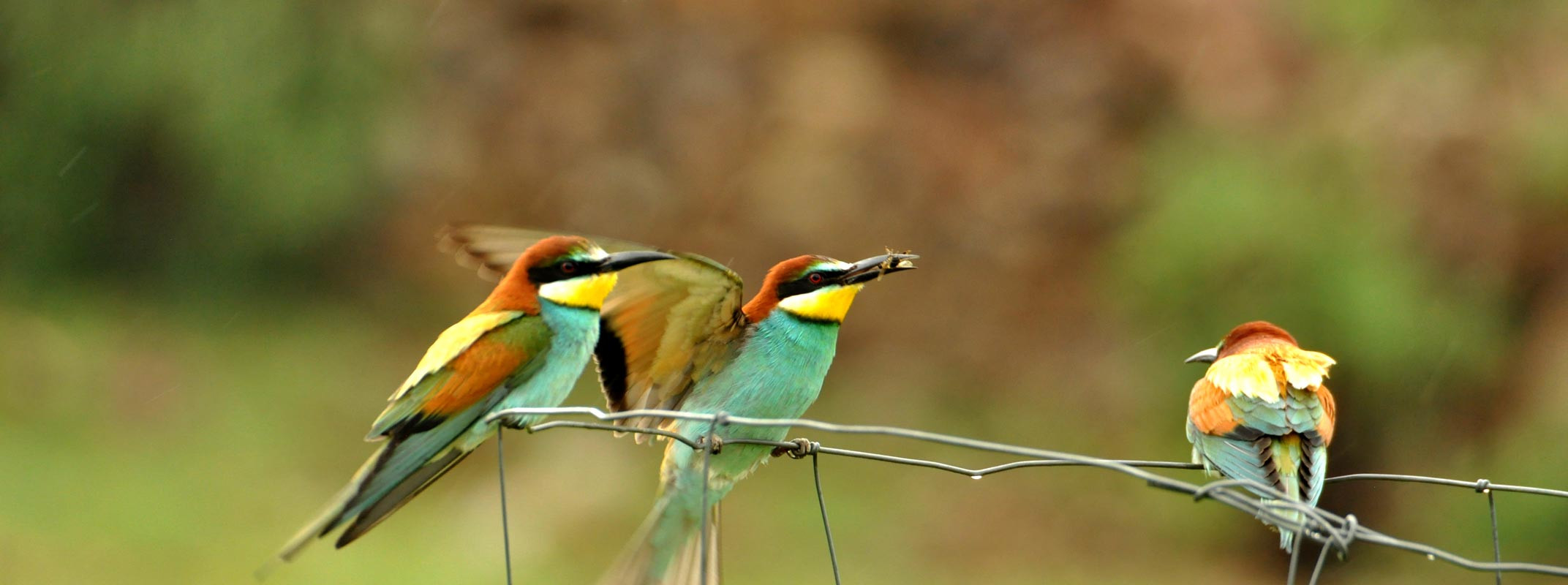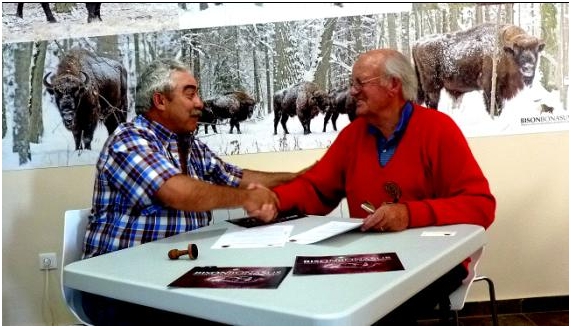

El Ayuntamiento de San Cebrián de Mudá y Fundación Monte Mediterráneo firman un convenio de colaboración para la recuperación de la trashumancia.
San Cebrián de Mudá, 14 de septiembre de 2011.- El Alcalde de San Cebrián de Mudá, Jesús González Ruiz y el Presidente de la Fundación Monte Mediterráneo, Hans-Gerd Neglein, firmaron hoy un convenio, en la sede del consistorio palentino, para usar la trashumancia como gestión del territorio.

Ambos llevan años apostando por una comprensión del rural, de una actividad ganadera y producción de biodiversidad de la que son protagonistas ganaderos, bisontes, ovejas trashumantes, osos y urogallos.
Entre los objetivos del convenio están la creación de un espacio de acción sobre el papel a jugar de las ovejas trashumantes -estratégica y conocida actividad abandonada- dentro del nuevo escenario rural. Más allá de la pura actividad de abasto, se rescatan los elementos de identidad compartida entre las dehesas mediterráneas y los puertos de montaña cantábricos que les permita mantenerse como ecosistemas altamente productivos de biodiversidad y corregir la deriva actual debida a la aplicación de normativas y hábitos erróneos que suponen pérdida de población, tradición, identidad y también de biodiversidad.
En este sentido, el convenio pretende cubrir las siguientes demandas:
- Producir biodiversidad de forma activa y rentable.
- Consolidar y ampliar la iniciativa trashumante que Fundación Monte Mediterráneo viene desarrollando desde hace varios años.
- Participar en la búsqueda de escenarios favorables para la recuperación de la actividad trashumante como activo del desarrollo rural y productor de biodiversidad.
- Impulsar la información y formación para replicar la iniciativa en más puertos.
- La colaboración entre territorios necesitados, para restablecer espacios de beneficio mutuo, hoy olvidados, con nuevos objetivos.
La innovación consiste en utilizar a las ovejas para mejorar dehesas y puertos, aprovechar los pastos en ambos territorios y aumentar las poblaciones de las especies más amenazadas, linces, águilas imperiales, osos y urogallos mediante una acción de estrategia, lógica y sentido común, utilizada en España desde tiempos inmemoriales.
PRESSENOTIZ
Die Gemeinde San Cebrián de Mudá und Fundación Monte Mediterráneo unterzeichnen ein Zusammenarbeitsabkommen zur Wiederbelebung der Transhumanz.
San Cebrián de Mudá, 14. September 2011. Der Bürgermeister der Gemeinde San Cebrián de Mudá, Jesús González Ruiz und der Präsident der Stiftung Fundación Monte Mediterráneo, Hans-Gerd Neglein, unterzeichneten heute im Gemeinderatsgebäude von San Cebrián de Mudá ein Abkommen zur Wiederbelebung der Transhumanz (d.h. von Süden nach Norden ziehende Schafherden) als landwirtschaftliches Instrument.

Beide setzen sich seit Jahren für die Entwicklungen in ländlichen Gebieten ein. Sie versuchen, land- und viehwirtschaftliche Prinzipien mit jenen, die zur Produktion der Biodiversität beitragen, zu verbinden, wobei die Protagonisten sowohl von Süden nach Norden ziehende Schafe, als auch Wisente, Bären und Auerhähne sind.
Eines der Ziele des Abkommens ist die Schaffung eines Raumes, in dem die Transhumanz, weitreichend bekannte, aber leider verloren gegangene Aktivität, Teil der Strategie zum Verständnis der neuen ländlichen Gebiete wird.
Weit mehr als die reine Beweidungstätigkeit geht es um die Rettung einer gemeinsamen Identität der andalusischen Dehesas und der cantabrischen Berglandschaften, die es erlaubt, diejenigen Gebiete, die hohe Biodiversitätserzeuger sind, zu erhalten und fehlgelaufene Entwicklungen zu korrigieren, welche zu einem enormen Verlust an Identität, Tradition, Biodiversität und letztendlich auch der Bevölkerung selbst geführt haben.
In diesem Sinne möchte das Abkommen folgende Bereiche umfassen:
- Aktiv und rentabel Biodiversität produzieren
- Die Initiative zur Transhumanz von Fundación Monte Mediterráneo zu konsolidieren und erweitern
- Suche nach günstigen Szenarien, die es erlauben, die Transhumanz als aktives Element der ländlichen Entwicklung und der Produktion von Biodiversität zu erleben
- Sowohl Information als auch Ausbildung und Schulung in diesem Sinne voran zu treiben, so dass weitere Berggebiete sich integrieren können
- Förderung der Zusammenarbeit zwischen förderungsbedürftigen Gebieten, so dass neue Räume und Zielsetzungen für beide gefunden werden können
Die Innovation besteht darin, die Schafherden sowohl zur Verbesserung der Dehesas als auch der Berglandschaften im Norden einzusetzen; die Schafe zur Verbesserung beider Gebiete zu nutzen und so die Artenvielfalt von zum Teil gefährdeten Arten, in beiden Gebieten zu fördern: Luchs, Kaiseradler, Bär, Auerhahn. Es geht um die Anwendung uralter und erprobter Strategien, die dank gesundem Menschenverstand, Logik und Strategie seit Menschengedengen in Spanien angewandt wurden.
NEWS RELEASE
The municipality of San Cebrián de Mudá and Fundación Monte Mediterráneo sign an agreement for cooperation to augment the movement of sheep herds between the South and the North of Spain (span.: trashumancia)
San Cebrián de Mudá, September, 14th, 2011. The Lord Mayor of San Cebrián de Mudá, Jesús González Ruiz and the President of Fundación Monte Mediterráneo, Hans-Gerd Neglein, signed today an agreement to augment the “trashumancia”.

Both partners have been involved in various activities to promote new activities and perspectives to improve the development of rural areas matching agro-silvo-pastorile activities with the production of biodiversity.
The present agreement is meant to expand the activities as well as geographically as well as in variety focusing on the moving sheep herds, bisons, bears and mountain cocks, among others.
Future common activities and efforts are meant to correct errors in the development in rural areas that lead to the loss of biodiversity, tradition, identity and even the population.
Basic ideas are:
- Active and cost-efficient production of biodiversity.
- Expand Fundación Monte Mediterráneo´s initiative to revitalize the “trashumancia”.
- Identify suitable sceneries to develop the “trashumanz” as an active element for rural development combining agro-pastorile activities with the production of biodiversity.
- Improve information and education relationship with Southern and Northern grazing areas.
- Improve cooperation between disadvantaged areas in order to find elements that both can identify with.
The innovation consist in using the same sheep herds to produce biodiversity as well in the South (dehesa) as well in the North (montañas palentinas) by grazing in different times of the year in different places – improving both agro-ecosystems that way, system that has been practiced in Spain for centuries and has almost been forgotten.
